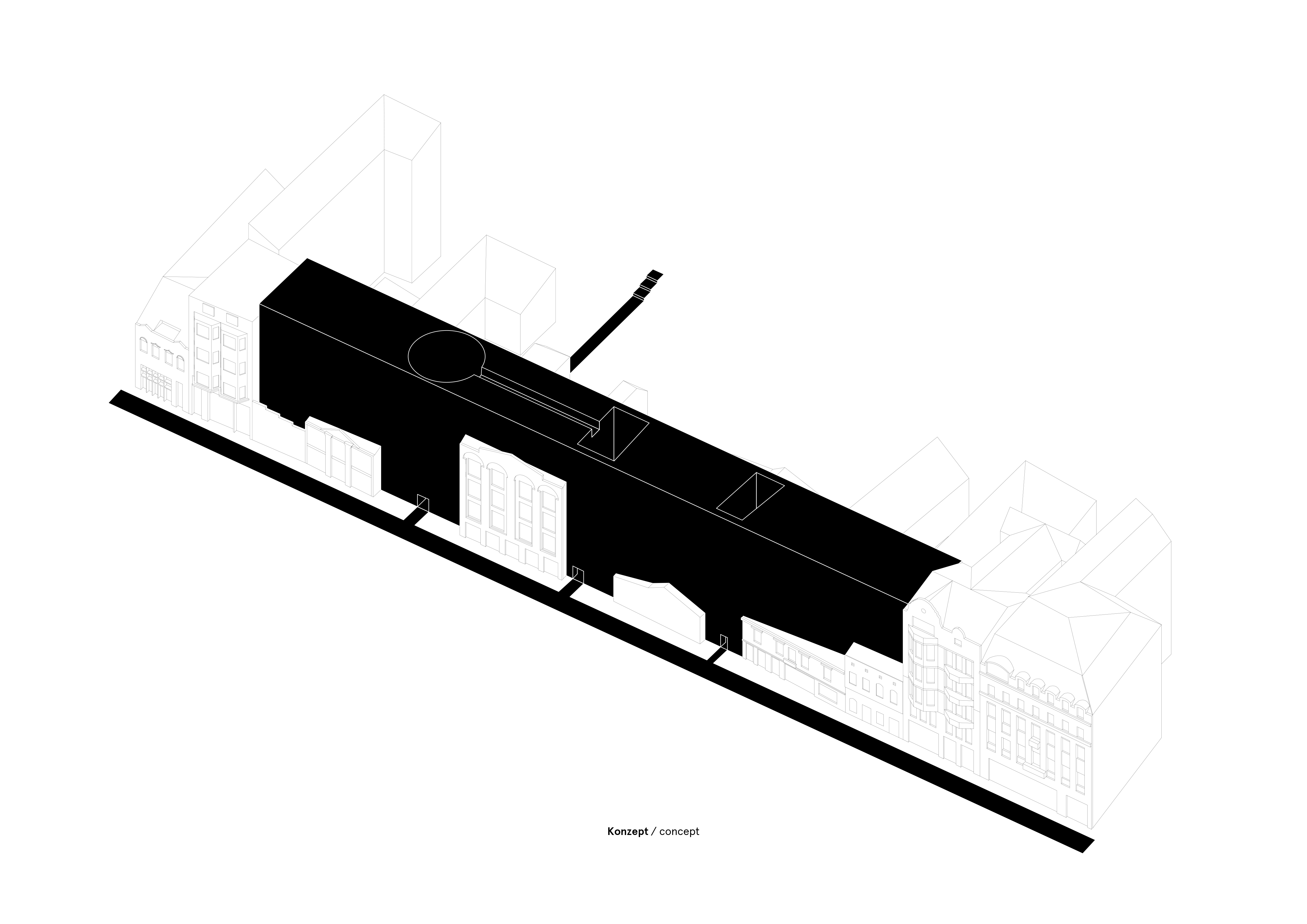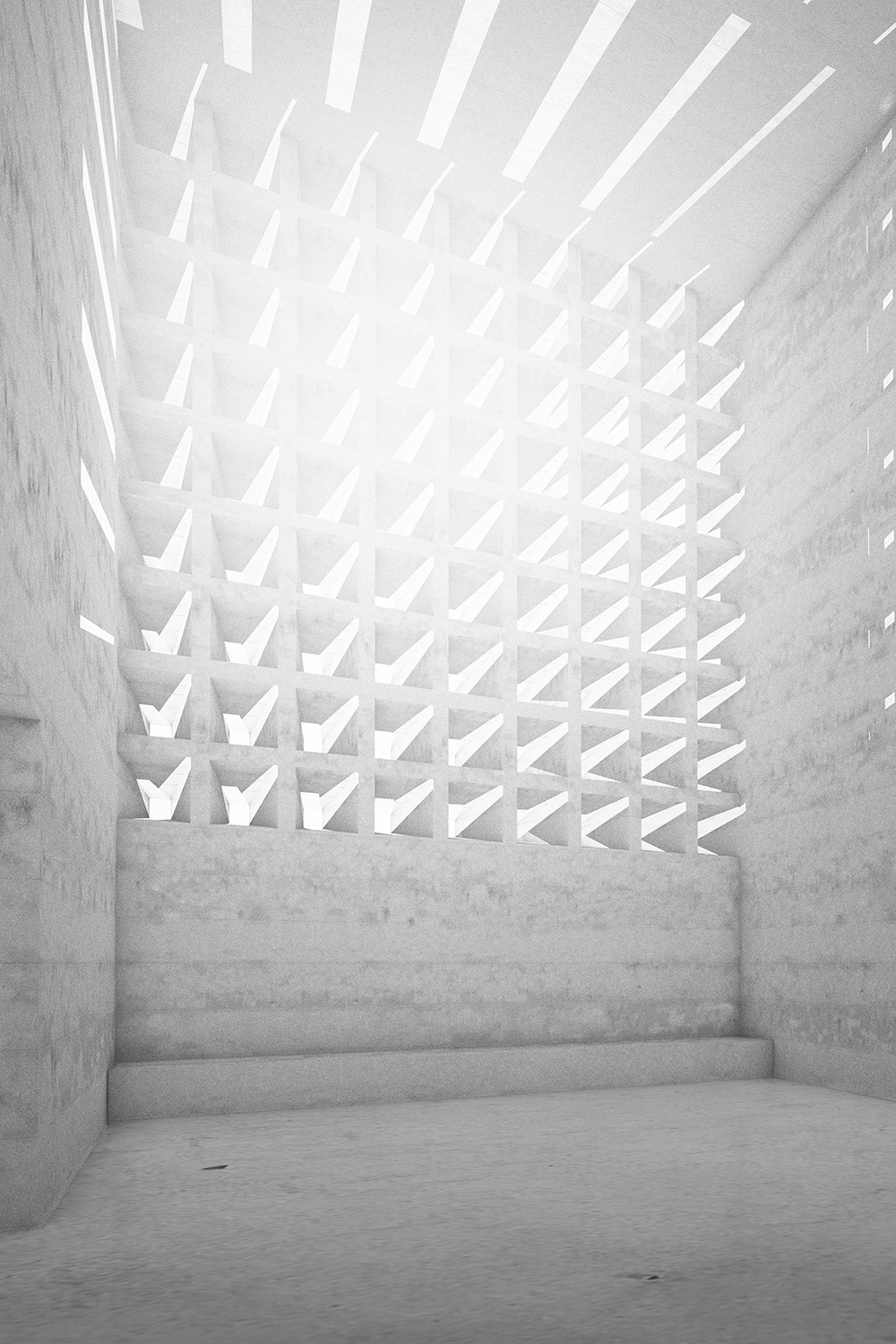Sehnsucht nach Erinnerung, Belgrad
longing for remembrance, Belgrade
longing for remembrance, Belgrade





















Die Vergangenheit in der Gegenwart zu verankern ist die Idee, die hinter diesem Gebäude steht. Der Vergangenheit ein Bild zu geben, es Teil der Identität Serbiens werden zu lassen. Einen Ort zu schaffen, der gleichzeitig Denkmal und Mahnmal ist und nicht nur auf vorwurfsvolle sondern auch auf wertschätzende Art Raum schafft für die Geschichte Serbiens und Jugoslawiens. Da der Krieg erst in jüngster Geschichte sein Ende nahm, sind die Wunden zu frisch und das Thema zu sensibel, um durch den Versuch einer objektiven Darstellung der Geschehnisse eine Klarstellung zu erreichen. Um zunächst das Tabu zu brechen, eine öffentliche Debatte um die unrühmliche Vergangenheit zu beginnen, wollen wir einen Ort des Verweilens inmitten der ehemaligen Prachtstrasse Belgrads integrieren.
Durch eine imaginäre Schalung von 10 Metern Tiefe wird die ehemalige Häuserzeile bis zur höchsten Traufhöhe nachgeahmt und der entstehende Raum zwischen und über den Gebäuden mit dem Schutt der Kriege aufgefüllt. Viele prägnante Gebäude wurden durch die Natobombadierung im Jahr 1999 in Belgrads Innenstadt zerstört und deren Schutt und die stehengebliebenen Ruinen wurden im Zentrum vernachlässigt. In einem neuartigen Beton soll der Schutt als Zuschlag fungieren, gleichzeitig aber auch in der Fassade klar zu erkennen sein. Der so aufgehäufte Schuttberg zwischen den Häusern soll nicht nur Ausdruck der Zerstörung und des vergangenen Leids sein, sondern auch fester und neuer Bestandteil der Stadtidentität werden.
The idea of the building is to fix the past into the present, to picture the past and to let it be part of the Serbian identity. It is a place, both monument and memorial, which makes room not only in a reproachfully but also in a valuing way for the history of Serbia and Yugoslavia. Due to the fact that the Balkan Wars of the 90s ended in recent history, the wounds are too fresh and the topic is too sensitive to try an objective representation of the events. To break the taboo and to start a public discussion about the inglorious past, we wanted to create a place for lingering in the middle of the former boulevard of Belgrade.
Through an imaginery formwork of 10 meter depth, the old row of houses will be imitated to the highest eaves height and will be filled up with the rubble of the Balkan Wars. During the NATO-bombardement in 1999, a lot of concise buildings in the city center of Belgrade were destroyed and the rubble and the ruins which remained standing were completely neglected.
The rubble should be used as a supplement in an innovative concrete and should be identified in the facade. The so-raised rubble-mountain between the houses should not only be an expression of destruction and the suffering caused in the last years, but also a new and inherent part of the urban identity.
Durch eine imaginäre Schalung von 10 Metern Tiefe wird die ehemalige Häuserzeile bis zur höchsten Traufhöhe nachgeahmt und der entstehende Raum zwischen und über den Gebäuden mit dem Schutt der Kriege aufgefüllt. Viele prägnante Gebäude wurden durch die Natobombadierung im Jahr 1999 in Belgrads Innenstadt zerstört und deren Schutt und die stehengebliebenen Ruinen wurden im Zentrum vernachlässigt. In einem neuartigen Beton soll der Schutt als Zuschlag fungieren, gleichzeitig aber auch in der Fassade klar zu erkennen sein. Der so aufgehäufte Schuttberg zwischen den Häusern soll nicht nur Ausdruck der Zerstörung und des vergangenen Leids sein, sondern auch fester und neuer Bestandteil der Stadtidentität werden.
The idea of the building is to fix the past into the present, to picture the past and to let it be part of the Serbian identity. It is a place, both monument and memorial, which makes room not only in a reproachfully but also in a valuing way for the history of Serbia and Yugoslavia. Due to the fact that the Balkan Wars of the 90s ended in recent history, the wounds are too fresh and the topic is too sensitive to try an objective representation of the events. To break the taboo and to start a public discussion about the inglorious past, we wanted to create a place for lingering in the middle of the former boulevard of Belgrade.
Through an imaginery formwork of 10 meter depth, the old row of houses will be imitated to the highest eaves height and will be filled up with the rubble of the Balkan Wars. During the NATO-bombardement in 1999, a lot of concise buildings in the city center of Belgrade were destroyed and the rubble and the ruins which remained standing were completely neglected.
The rubble should be used as a supplement in an innovative concrete and should be identified in the facade. The so-raised rubble-mountain between the houses should not only be an expression of destruction and the suffering caused in the last years, but also a new and inherent part of the urban identity.